We have an old Lutron system that works well and we’ve been waiting for the turning point when LEDs are really affordable in all sizes (see below). They are supposed to last 10x longer than incandescent and be 10x more efficient although the ones we’ve used earlier have definitely failed early:
- Philips non-dimmable 100-watt equivalent LED bulbs have dropped to $4/bulb in a pack of 8 with 15x the life of incandescent at Amazon. These are the traditional bulbs (aka A19 Shape and E26 socket).
- Phillips dimmable 60-watt equivalent at $3.83 which are 6 for $23 at Amazon.
Next, smart bulbs could finally let us replace the system completely. These are Wifi connected devices that work with inexpensive hubs which can then communicate with home assistants from Amazon, Apple and Google. The day seems like it is getting close to doing a complete replacement that will use much less energy:
- Most sites are recommending the Philips Hue bulbs. They use conventional Wifi, so if you have good coverage, you don’t have to have an overlay like Zigbee.
- You can get.Philips Hue White bulbs which are LED and a 60 watt equivalent. They last 15-22K hours so 15x longer than a conventional bulb. You can get 4 bulbs for $50 at Amazon or $12.50 a bulb. You get two bulbs for $30 or $15 a bulb.
- You do need one Philips Hub for every 50 bulbs. So most homes won’t need more than one. The pricing for hubs is a little complicated because of bundling, basically bundling ties 4 A19 bulbs with E26 base to a single hub for $90 at Amazon or 2 A19 bulbs plus hub for $70 at Amazon. This translates into $40 for a hub. Note that the bulbs in this pack are tied to the hub, so get one hub and then lots of extras.
- The hub can then talk with Apple HomeKit, Alexa on Echo and Google Home. Or you can use the standalone Philips Hue application. Since they have open sourced all the code for this, you can even role your own. The nice thing is that you do not have to buy an expensive proprietary control system like Lutron. For instance, you can have lights that are timed to the music you are playing.
They also have some extra goodies that are interesting to try:
- Hue White and Color Ambiance. These are multi-color LED bulbs for mood lighting but they are $47 at Amazon, so pretty pricy and really for special applications.
- Smartsense by Sengled. These are Motion sensitive PAR38. These are LEDs that have a motion sensor built into them. These are great for security uses. You don’t need to have them on all the time and they should last longer too. Way easier than the older designs that had a motion sensor on a stalk. These are 2 for $32 from Amazon for outdoor PAR38s. Or for indoor, they are $28 for 2 BR30 LEDs at Amazon.
OK there is a nerd aside, I finally spent an hour actually understanding bulb nomenclature and here are the two things to know, you basically spec a bulb by the time of base (how it screws in) and it’s shape. So for instance a regular light bulb is technical an E26 base with A19 shape:
- Edison screw. These are the screw in bulbs. The dimensions are in eights of an inch or in millimeters. So an E26 bulb is 26mm wide also called medium base. Then E12 is narrow base.
- Bi-pin base. These are low voltage typically 12V and they are denoted by the letter G and then the center-to-center distance between the pins. The G means “Glass” from the original models developed in the 19th century (?!).
There are standard bulb shapes and some common Bulb shapes are the second thing to know so some common examples are:
- A19. These are the bulb shapes where the number is the width of the bulb. The A19 is the familiar light bulb size that is 19 * ?” or 2 ?” inch di.ameter
- T4. This is a tubular shape. So a T4 E12 would be a candelabra base
- CR means candelabra shape
There there is a set of flood light bulbs with some confusing names. The main difference is that PAR is outdoor capable. For indoor use, the big difference is width of the beam
- PAR30 and PAR38. This means parabolic aluminum reflector in the 38 x 1/8ths of an inch. These are outdoor lights at 45 degrees so great for outdoors.
- BR38. These bulging reflectors. These have the widest spread at 90 degrees. These are good for general lighting when you want to illuminate a large area.
- MR. Mirrored reflectors. These are the most focused at 15-45 degrees, so good for spot lights and highlights.
If you are wondering how this all works:
- They use something called Zigbee which is a low-speed networking that works at 800, 900 and 2.4GHz. This is supposed to be lower power and work up to 100 feet.
- The little puck that you buy is a Zigbee receiver, so everything is a star network to that device. It then plugs into your Ethernet via a wired connection. So you will need more than one puck (Philips license the Belkin hub for this purpose).
- Naturally security is a big issue, so I’m guessing hacked light bulbs will be a thing shortly.






